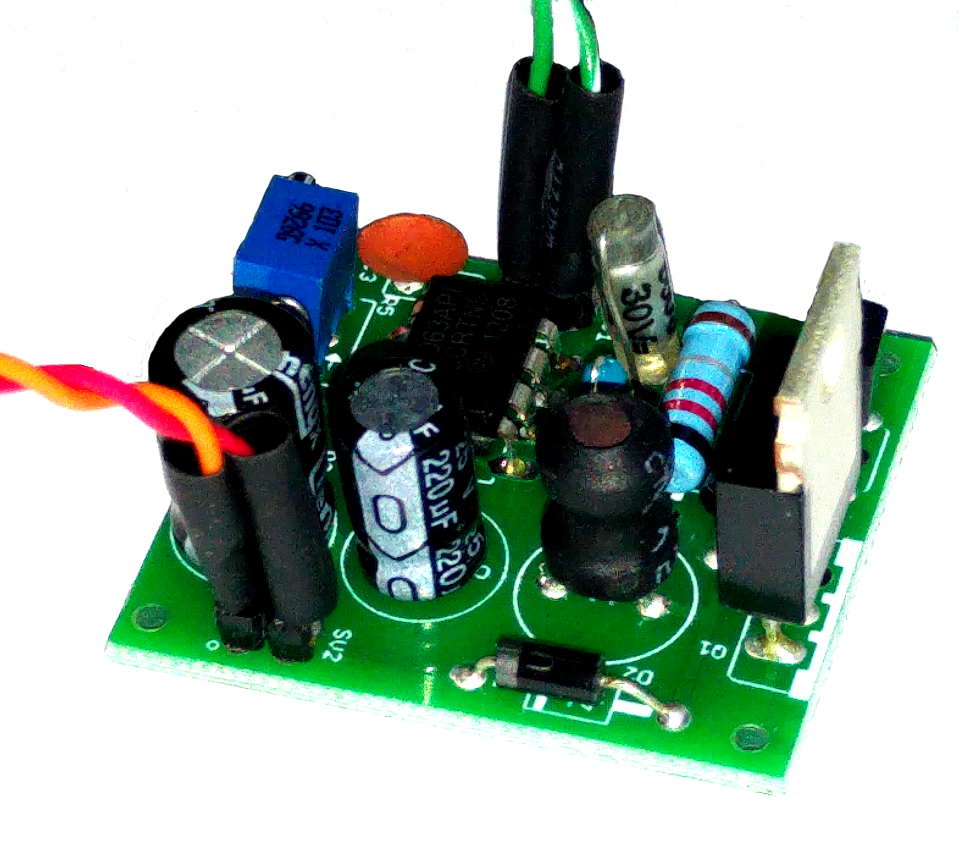Non-Clocks
- Details
You are a Nixie Nerd. It's a long, dark evening. There's nothing left to build, What do you do?
You read the bible. The Nixie Bible.
I found this text hard to find. Then Judge told me where it was. For the benefit of others, I am posting it here:
https://archive.org/details/ColdCathodeTubes
Thanks for that, Judge!
- Details
Philips PM 2422A Multimeter
In the post today a new piece of equipment arrived from a friend of mine in the Netherlands, who spends far too much time in electronic junk yards, fishing for equipment to make things out of. He recently found an original Philips PM2422A multimeter with ZM1000 tubes. He was kind enough to send it to me. This is the opening of the package and the testing to make sure that it had arrived safely.
The meter uses 3 ZM1000 tubes, a "half digit" tube, capable of displaying a "1", and another small tube, capable of displaying a "-". I have no idea what the "half tubes" are. Here is a picture of the ZM1000 tubes in their original location:
The "half tubes" can be seen to the right of the three ZM1000s: there is a tall thin one, which shows the "1", and a round one (with the yellow wire) which is the "-".
There is also plenty of dust in there as well.
Here's the video of the unboxing:
Service manuals
One thing that manufacturers of today should take notice of, is that equipment of the era the PM2422A was made in always had a service manual available for them. This one has a chunky 62 page manual that explains everything about the way the unit works, as well as detailed instructions how to maintain and trouble shoot the unit. Try finding a piece of equipment with that level of detail today!
If you want to have a look at the manual, it is here: https://www.tubeclockdb.com/downloads/Philips_PM2422A_ENG.pdf
Links
- Details
I really struggled when I was writing this, and even after thinking about it some more, I'm still not convinced I got the right answer. Perhaps I'll never know, and will always have to live with that nagging feeling that things might have been different, if only I had made a different decision...
I was poking around on http://hackaday.com/ and found this: http://hackaday.com/2015/07/14/unusual-nixie-tubes-lead-to-unique-clock/. It's a clock. That's what the title says.
My issue was that it was hard to decide what category to put it into, and in the end, only a process of elimination gave me an answer. The title says that it's a tube clock. Those are clearly tubes in there, but is it a clock? It's not based around Numitrons or VFDs, so clearly it doesn't belong there. It wasn't found on eBay, and no one submitted it, so those categories don't fit, either. But I can't quite bring myself to put it in the "Nixie Tube Clock" category, because I'm not sure it's really a clock.

So, apparently, according to the Merriam Webster definition, it is a clock, because you can tell the time with it. Only I can't. I guess it is my lack of imagination, or just that I'm neither fluent in octal time nor do the symbols mean very much to me. (Meaning they do, individually, in different contexts, but not here).
Octal? Yes, well, the tubes only have 8 cathodes in them, so as well as not understanding the digits, it's not even a number system you can use. Even the guy who made it has a chart next to it to decode the time it tells you. For example, the decimal time"12:34:55" becomes "14:42:67" in octal, or in the language of this clock "FV:VHz:HA". Or something. In any case, you're going to be late for that meeting.
Maybe I need to have a new category "Nixie Tube Stuff, but not a clock".
I do understand the idea. If you have a box of tubes with symbols on them, and don't make equipment to measure Frequency, Resistance or Volts, what are you going to do with them? I have a box of IN-15s, and I have no idea what to do with them.
So, in the end, I put it into the "Non-Clocks" category. Perhaps I'm wrong.
Here's a full video of the madness:
Let me know what you think in the comments. Am I a small-minded bourgeois square with no imagination, or should we all have one of these?
- Details
We're clearing out the catalogue at the moment, and found this design for a tried and tested Adjustable High Voltage Generator, which we used to sell, but have archived now, simply because there are so many designs out there, we can't make any money off it.

So, we're putting this design out there in the public domain, for anyone who wants to use as they see fit. There's nothing really special about the design, but it's a tried and tested unit, of which we have sold hundreds in the past.
The output voltage is continuously adjustable from 40V to over 200V and the output power is up to 5W.
The Eagle project is here:
This is a decommissioned Eagle project, which we used to sell, but there are so many possibilities out there, we decided to just make this public domain.
Enjoy!
- Details
I have been working with Alex from Ireland for a long time to make a range of unique retro Nixie clocks. At first he just bought a few clock kits, and then he started talking about some of his designs. It sounded interesting that he was spending his time going around industrial breaker's yards and picking up bits and pieces that no one else could see a use for, and using them to create something new. I had trouble imagining what he was doing, and didn't ask further. He had trouble with a few of the kits and we started to talk about what he was doing.
The out of the blue, he sent me some pictures of what we was building and I was amazed to see the irony and humour in the Post-Industrial work that he was doing. I was confused. What was a clock builder doing creating this sort of work? Creatures made from switch boxes and light housings? What was it all about?
Well, it turns out that Alex is in fact first and foremost a passionate artist, and works with objects that he finds as scrap to give them new life as something they were never intended to be. He's built a private zoo of post modern creatures, some of them vaguely disturbing, and some of them just plain funny.
He's still working on the clocks at this point, but you can see the level of workmanship and imagination that Alex uses, so I can't wait to see what he comes up with.
Here a few more of the many images that he sent me. Enjoy!
If you appreciate non-clock features, please leave a comment! I know that it is not really "on-topic", but I just had to share it with you!
- Details
I received an Azevedo NWTS module last week, and got around to building it today, following the clear instruction manual. More about this later. 
NWTS is a "NTP to WiFi Time Synchonization" module, primarily intended for Nixie Clocks, but you could also use it for any other purpose where you want a reliable source of time, over a GPS like interface. Azevedo devices worked with Mr.Nixie to come up with a small, neat device that plugs into Mr.Nixie clocks as well as PV Electronics clocks. It's not just limited to those clocks. It should work with any clock that uses the GPS NMEA protocol and standard electrical characteristics (and most clocks do).
Why not just use GPS?
I can answer that one: I live in a tall building, with poor line of sight access to a GPS signal. If I try really hard, and put the clock close to the window on the right side of the house, I can eventually get a GPS lock. It takes time, and it's not very reliable. If you're out in the country, it may be way easier to get a good signal, but in a densely populated part of town, it's a problem. At least it's a problem for me.
Apart from that, I don't want my clock near the window on the wrong side of the house. I want it to be where I am most of the time, and where I can see it.
So, in my house, I don't have a good GPS signal, but I do have a good WiFi network, and out there on the net there are NTP (Network time Protocol) servers, which are synchonized to the same atomic clocks as the GPS satellites.
Azevedo and Mr.Nixie came up with an idea to have a WiFi connected device, which pretends to be a GPS module. Neat... Problem solved!
Building the module

It's a cute little module, and the build was very straightforward using the excellent instructions. You can find the latest manual here. For me, the total build time was about 20 minutes (but I am quite fast). All of the components are through hole, and don't really require any special tools or skill. There is only one thing that requires extra care: the voltage regulator and the transistor have very small TO-92 pads, and you'll have to be careful not to make solder bridges on these.

Apart from that the build is very straightforward and easy to follow. The component count is not huge, and all of the complexity is really on the tiny ESP-8266 module. The ESP-8266 is a tiny "maker" module which combines a micro-controller, (like the one in the clock itself, but more powerful), and a WiFi interface. The ESP-8266 is a miracle of modern electronics. The squiggle on the left of the board is the WiFi antenna, the black chip on the bottom is the controller, and the 8-legged chip above it is the flash EEPROM.
Here is a time lapse of the build process:
Using the module
After completing the build, I plugged in the module to one of my PV Electronics QTC clocks. Disappointment. Nothing happened. No time synchronization and no difference in the time the clock showed. The build had been so simple that I had skipped over the rest of the manual and had not bothered to read it. Everyone hates reading the manual, but this time I had to do it. There were two things to configure:
Because of where I live, I had never bothered to configure the clock with a GPS interface. Going into the clock configuration, I had to configure the "Radio time signal source" to use GPS (option "4" in my case), and set the baud rate of the interface to 9600 baud (option "1" in my case). Neither of these were the default settings, so you will need to do this step on your clock.
After that, I had to configure up the nwts module. To do this, you have to log into it with a phone, tablet or PC, and tell it the SSID ("WiFi name") and password of your home WiFi network. To do this, you have to connect to the WiFi access point provided by the nwts. I found the task of logging in the first time to be a little fiddly. At first my phone didn't want to connect to it and kept falling back to the WiFi network. After I told the phone to "forget" the home WiFi network it connected correctly and I was able to configure the unit.
After turning everything off and back on again, the tiny blue LED on the ESP-8266 started to blink correctly, and within two seconds, the time was synchronized on the clock!
Here is a video of the process of starting up the clock, and how quickly the time is synchronized:
Last impressions
I use the module on my clock now, simply because it's fast to synchronize and I don't need to touch the clock again. For me, GPS was not an option, as noted before, and I had stopped using the PV Electronics clock because it wasn't as accurate as the phone I carry around with me all the time. The phone is not as cool as the clock, but I don't need a clock that tells me the wrong time. I love the "fit and forget" nature of the module, and now that I have a cool clock that knows the time, I have put the PV Electronics clock back where it was in my living room.
If you want to get one of the Azevedo nwts modules, you have find them on Tindie or by clicking on this button:


